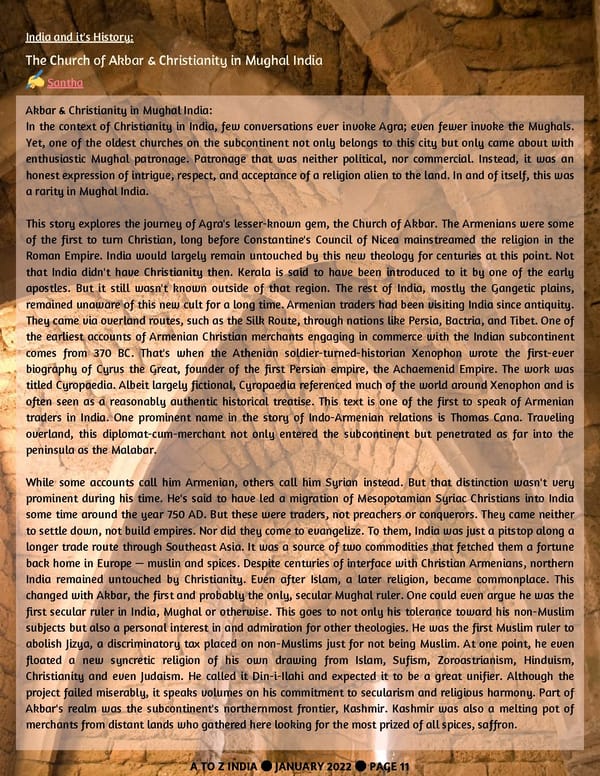Akbar & Christianity in Mughal India: In the context of Christianity in India, few conversations ever invoke Agra; even fewer invoke the Mughals. Yet, one of the oldest churches on the subcontinent not only belongs to this city but only came about with enthusiastic Mughal patronage. Patronage that was neither political, nor commercial. Instead, it was an honest expression of intrigue, respect, and acceptance of a religion alien to the land. In and of itself, this was a rarity in Mughal India. This story explores the journey of Agra's lesser-known gem, the Church of Akbar. The Armenians were some of the first to turn Christian, long before Constantine's Council of Nicea mainstreamed the religion in the Roman Empire. India would largely remain untouched by this new theology for centuries at this point. Not that India didn't have Christianity then. Kerala is said to have been introduced to it by one of the early apostles. But it still wasn't known outside of that region. The rest of India, mostly the Gangetic plains, remained unaware of this new cult for a long time. Armenian traders had been visiting India since antiquity. They came via overland routes, such as the Silk Route, through nations like Persia, Bactria, and Tibet. One of the earliest accounts of Armenian Christian merchants engaging in commerce with the Indian subcontinent comes from 370 BC. That's when the Athenian soldier-turned-historian Xenophon wrote the first-ever biography of Cyrus the Great, founder of the first Persian empire, the Achaemenid Empire. The work was titled Cyropaedia. Albeit largely fictional, Cyropaedia referenced much of the world around Xenophon and is often seen as a reasonably authentic historical treatise. This text is one of the first to speak of Armenian traders in India. One prominent name in the story of Indo-Armenian relations is Thomas Cana. Traveling overland, this diplomat-cum-merchant not only entered the subcontinent but penetrated as far into the peninsula as the Malabar. While some accounts call him Armenian, others call him Syrian instead. But that distinction wasn't very prominent during his time. He's said to have led a migration of Mesopotamian Syriac Christians into India some time around the year 750 AD. But these were traders, not preachers or conquerors. They came neither to settle down, not build empires. Nor did they come to evangelize. To them, India was just a pitstop along a longer trade route through Southeast Asia. It was a source of two commodities that fetched them a fortune back home in Europe — muslin and spices. Despite centuries of interface with Christian Armenians, northern India remained untouched by Christianity. Even after Islam, a later religion, became commonplace. This changed with Akbar, the first and probably the only, secular Mughal ruler. One could even argue he was the first secular ruler in India, Mughal or otherwise. This goes to not only his tolerance toward his non-Muslim subjects but also a personal interest in and admiration for other theologies. He was the first Muslim ruler to abolish Jizya, a discriminatory tax placed on non-Muslims just for not being Muslim. At one point, he even floated a new syncretic religion of his own drawing from Islam, Sufism, Zoroastrianism, Hinduism, Christianity and even Judaism. He called it Din-i-Ilahi and expected it to be a great unifier. Although the project failed miserably, it speaks volumes on his commitment to secularism and religious harmony. Part of Akbar's realm was the subcontinent's northernmost frontier, Kashmir. Kashmir was also a melting pot of merchants from distant lands who gathered here looking for the most prized of all spices, saffron. The Church of Akbar & Christianity in Mughal India Santha India and it's History: A TO Z INDIA ● JANUARY 2022 ● PAGE 11
 A TO Z INDIA - JANUARY 2022 Page 10 Page 12
A TO Z INDIA - JANUARY 2022 Page 10 Page 12